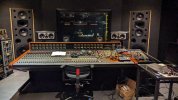Imo flush-mounting speakers has definite advantages. In addition to eliminating baffle step and SBIR effects, edge diffraction is eliminated, as is the reflection off the wall behind the speakers. Edge diffraction degrades imaging precision and can be a source of coloration, and the reflection off the wall behind the speakers can likewise be a source of coloration and is often a strong "small room signature" cue that tends to constrain the depth of the soundstage.
So not only is the lower midrange and bass response improved, coloration is reduced, along with the "you're listening to speakers... in a small room" cues. So you hear more of the spatial information on the recording.
You may end up with too much lower midrange and bass energy if the speaker was "voiced" for normal free-standing use.
And make sure you get the toe-in angle right before you build the walls!
Here's a thread that shows a flush-mounted system I made for a customer (he did the actual installation); the main monitors' axes cross a little bit behind the mix position:
Multi-award-winning studio designer Jeff Hedback offered me the opportunity to bid on providing custom main monitors for a recording studio he designed, and his client accepted my bid. Jeff specified the tweeter height, outer dimensions, and look-down angle. The installation is in-wall, so the...

www.audiosciencereview.com


